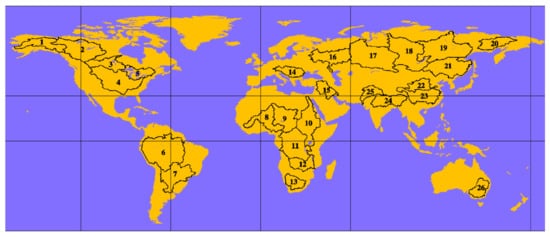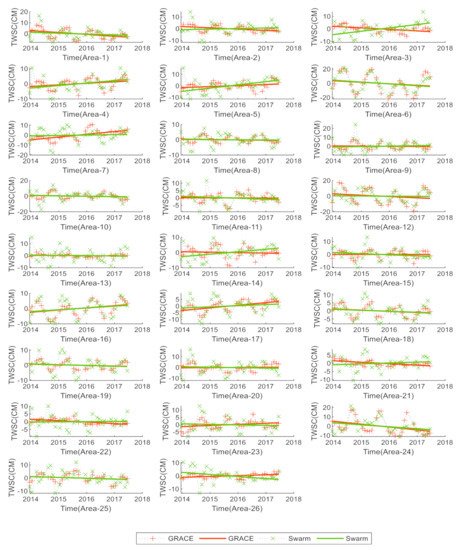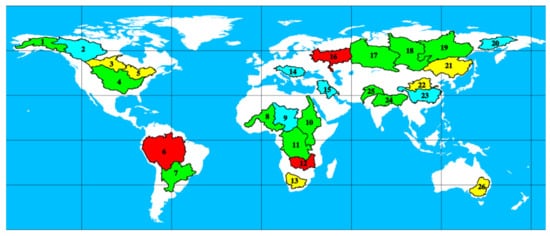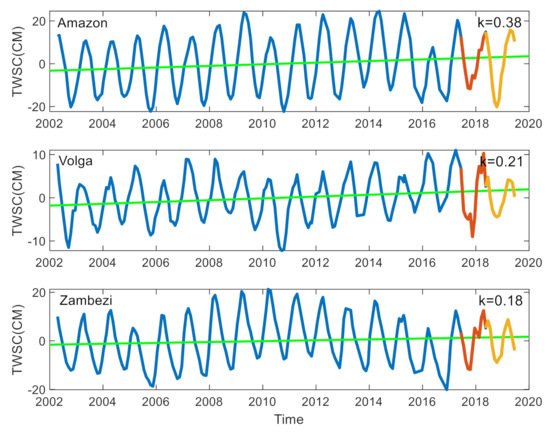1000/1000
Hot
Most Recent

The Gravity Recovery and Climate Experiment (GRACE) satellite provides time-varying gravity field models that can detect total water storage change (TWSC) from April 2002 to June 2017, and its second-generation satellite, GRACE Follow-On (GRACE-FO), provides models from June 2018, so there is a one year gap. Swarm satellites are equipped with Global Positioning System (GPS) receivers, which can be used to recover the Earth’s time-varying gravitational field. Swarm’s time-varying gravitational field models (from December 2013 to June 2018) were solved by the International Combination Service for Time-variable Gravity Field Solutions (COST-G) and the Astronomical Institute of the Czech Academy of Sciences (ASI). On a timely scale, Swarm has the potential to fill the gap between the two generations of GRACE satellites.

| NO | Basin | Location | NO | Basin | Location | NO | Basin | Location |
|---|---|---|---|---|---|---|---|---|
| 1 | Yukon | North America | 10 | Nile | Africa | 19 | Lena | Asia |
| 2 | Mackenzie | North America | 11 | Congo | Africa | 20 | Kolyma | Asia |
| 3 | Nelson | North America | 12 | Zambezi | Africa | 21 | Amur | Asia |
| 4 | Mississippi | North America | 13 | Orange | Africa | 22 | Huang He | Asia |
| 5 | St Lawrence | North America | 14 | Danube | Europe | 23 | Yangtze | Asia |
| 6 | Amazon | South America | 15 | Euphrates and Tigris | West Asia | 24 | Ganges and Brahmaputra | Asia |
| 7 | Parana | South America | 16 | Volga | Asia | 25 | Indus | Asia |
| 8 | Niger | Africa | 17 | Ob | Asia | 26 | Murray Darling | Australia |
| 9 | Lake Chad Basin | Africa | 18 | Yenisey | Asia |

| NO | Basin | Area (10,000 km2) | Runoff (km3) |
GRACE-Trend (cm/Year) |
Average Mass Change (km3) |
Swarm-Trend (cm/Year) |
Correlation Coefficient (%) | RMSE (cm) |
|---|---|---|---|---|---|---|---|---|
| 1 | Yukon | 83.5 | 200.6 | −1.69 | −14.11 | −0.77 | 62.44 | 4.03 |
| 2 | Mackenzie | 180.5 | 357.2 | −1.1 | −19.86 | 0.47 | 55.97 | 4.45 |
| 3 | Nelson | 115 | 74.7 | −1.21 | −13.91 | 2.68 | −1.62 | 5.88 |
| 4 | Mississippi | 323 | 599.5 | 1.02 | 32.95 | 1.64 | 58.3 | 3.94 |
| 5 | St Lawrence | 30 | 332.39 | 0.9 | 2.7 | 2.77 | 29.14 | 5.95 |
| 6 | Amazon | 691.5 | 6906.38 | −2.11 | −145.91 | −2.59 | 93.55 | 4.92 |
| 7 | Parana | 310.3 | 800 | 2.79 | 86.57 | 0.40 | 42.85 | 6.29 |
| 8 | Niger | 209 | 200 | −0.26 | −5.43 | −0.10 | 58.86 | 3.12 |
| 9 | Lake Chad Basin | 100 | 450 | −0.23 | −5.06 | 0.50 | 61 | 5.43 |
| 10 | Nile | 335 | 81 | −0.6 | −20.1 | −0.48 | 70.14 | 4.38 |
| 11 | Congo | 401 | 1292.98 | −0.07 | −2.807 | −0.67 | 57.66 | 3.46 |
| 12 | Zambezi | 138 | 311.1 | −1.68 | −23.18 | −0.27 | 71.56 | 6.86 |
| 13 | Orange | 102 | 15.45 | −0.2 | −2.04 | −0.15 | 5.36 | 5.65 |
| 14 | Danube | 81.7 | 203 | −0.31 | −2.53 | 1.61 | 32 | 4.96 |
| 15 | Euphrates and Tigris | 104.8 | 62.06 | 4.91 | 51.46 | −0.87 | 39.45 | 4.39 |
| 16 | Volga | 138 | 254.18 | 1.43 | 19.73 | 1.19 | 81 | 3.56 |
| 17 | Ob | 297 | 385 | 1.97 | 58.51 | 0.86 | 77.13 | 3.89 |
| 18 | Yenisey | 260.5 | 625.36 | −0.75 | −19.54 | −0.62 | 74.67 | 3.22 |
| 19 | Lena | 249 | 540 | −0.41 | −10.21 | −0.5 | 57.62 | 4.16 |
| 20 | Kolyma | 64.4 | 123 | 0.14 | 0.90 | −0.42 | 39.37 | 5.62 |
| 21 | Amur | 185.5 | 346.5 | −0.89 | −16.51 | 0.52 | 3.64 | 4.34 |
| 22 | Huang He | 79.5 | 58 | −0.93 | −7.39 | 0.12 | −8.31 | 4.79 |
| 23 | Yangtze | 180 | 1160 | 0.75 | 13.5 | −0.33 | 53.41 | 4.03 |
| 24 | Ganges and Brahmaputra | 132.6 | 165.4 | −3.09 | −40.97 | −2.09 | 73.56 | 6.05 |
| 25 | Indus | 116.55 | 207 | −0.63 | −7.34 | −0.65 | 52.06 | 4.73 |
| 26 | Murray Darling | 100 | 5.99 | 0.63 | 6.3 | −1.58 | −1.68 | 5.26 |
| Correlation Classification | Negative Strongly | Negative Weakly | Irrelevant | Positive Weakly | Positive Strongly |
|---|---|---|---|---|---|
| Correlation Coefficient (%) | [−100, 80) | [−80, 30) | [−30, 30] | (30, 80] | (80, 100] |
| NO | Basin | Cycle Repetition Time (Year) | NO | Basin | Cycle Repetition Time (Year) | NO | Basin | Cycle Repetition Time (Year) |
|---|---|---|---|---|---|---|---|---|
| 1 | Yukon | 3 | 10 | Nile | 3 | 19 | Lena | 3 |
| 2 | Mackenzie | 2.5 | 11 | Congo | 3 | 20 | Kolyma | 2.5 |
| 3 | Nelson | 2.5 | 12 | Zambezi | 3 | 21 | Amur | 1 |
| 4 | Mississippi | 3 | 13 | Orange | 0.5 | 22 | Huang He | 0.5 |
| 5 | St Lawrence | 1.5 | 14 | Danube | 3 | 23 | Yangtze | 2.5 |
| 6 | Amazon | 3.5 | 15 | Euphrates and Tigris | 2.5 | 24 | Ganges and Brahmaputra | 3 |
| 7 | Parana | 3 | 16 | Volga | 3.5 | 25 | Indus | 2.5 |
| 8 | Niger | 3 | 17 | Ob | 3 | 26 | Murray Darling | 1 |
| 9 | Lake Chad Basin | 2.5 | 18 | Yenisey | 3 |
| NO | Basin | Trend | Relevance | Similar Period Ratio |
|---|---|---|---|---|
| 1 | Yukon | Same | Positive Weakly | 86 |
| 2 | Mackenzie | Conversely | Positive Weakly | 71 |
| 3 | Nelson | Conversely | Irrelevant | 71 |
| 4 | Mississippi | Same | Positive Weakly | 86 |
| 5 | St Lawrence | Same | Irrelevant | 43 |
| 6 | Amazon | Same | Positive Strong | 100 |
| 7 | Parana | Same | Positive Weakly | 86 |
| 8 | Niger | Same | Positive Weakly | 86 |
| 9 | Lake Chad Basin | Conversely | Positive Weakly | 71 |
| 10 | Nile | Same | Positive Weakly | 86 |
| 11 | Congo | Same | Positive Weakly | 86 |
| 12 | Zambezi | Same | Positive Weakly | 86 |
| 13 | Orange | Same | Irrelevant | 14 |
| 14 | Danube | Conversely | Positive Weakly | 86 |
| 15 | Euphrates and Tigris | Conversely | Positive Weakly | 71 |
| 16 | Volga | Same | Positive Strongly | 100 |
| 17 | Ob | Same | Positive Weakly | 86 |
| 18 | Yenisey | Same | Positive Weakly | 86 |
| 19 | Lena | Same | Positive Weakly | 86 |
| 20 | Kolyma | Conversely | Positive Weakly | 71 |
| 21 | Amur | Conversely | Irrelevant | 29 |
| 22 | Huang He | Conversely | Irrelevant | 14 |
| 23 | Yangtze | Conversely | Positive Weakly | 71 |
| 24 | Ganges and Brahmaputra | Same | Positive Weakly | 86 |
| 25 | Indus | Same | Positive Weakly | 71 |
| 26 | Murray Darling | Conversely | Irrelevant | 29 |

| NO | Basin | Area (10,000 km2) |
Rank | Runoff (km3) |
Rank | Average Mass Change (km3) |
Rank | Instantaneous Change (cm) | Rank | Result Rank |
|---|---|---|---|---|---|---|---|---|---|---|
| 6 | Amazon | 691.5 | 1 | 6906.38 | 1 | −145.91 | 1 | 13.66 | 1 | 1 |
| 16 | Volga | 138 | 14 | 254.18 | 14 | 19.73 | 10 | 4.61 | 5 | 2 |
| 12 | Zambezi | 138 | 13 | 311.1 | 13 | −23.18 | 7 | 9.96 | 2 | 3 |
| 7 | Parana | 310.3 | 5 | 800 | 4 | 86.57 | 2 | 4.83 | 4 | 4 |
| 17 | Ob | 297 | 6 | 385 | 9 | 58.51 | 3 | 3.8 | 8 | 5 |
| 18 | Yenisey | 260.5 | 7 | 625.36 | 5 | −19.54 | 11 | 3.38 | 12 | 6 |
| 24 | Ganges and Brahmaputra | 132.6 | 15 | 165.4 | 19 | −40.97 | 5 | 8.94 | 3 | 7 |
| 10 | Nile | 335 | 3 | 81 | 21 | −20.1 | 8 | 3.75 | 9 | 8 |
| 1 | Yukon | 83.5 | 22 | 200.6 | 17 | −14.11 | 13 | 4.22 | 6 | 9 |
| 8 | Niger | 209 | 9 | 200 | 18 | −5.43 | 20 | 1.97 | 22 | 10 |
| 4 | Mississippi | 323 | 4 | 599.5 | 6 | 32.95 | 6 | 3.59 | 10 | 11 |
| 11 | Congo | 401 | 2 | 1292.98 | 2 | −2.81 | 22 | 3.02 | 18 | 12 |
| 19 | Lena | 249 | 8 | 540 | 7 | −10.21 | 16 | 2.57 | 19 | 13 |
| 25 | Indus | 116.55 | 16 | 207 | 15 | −7.34 | 18 | 3.1 | 16 | 14 |
| 9 | Lake Chad Basin | 100 | 20 | 450 | 8 | −5.06 | 21 | 3.35 | 13 | 15 |
| 2 | Mackenzie | 180.5 | 11 | 357.2 | 10 | −19.86 | 9 | 2.75 | 21 | 16 |
| 23 | Yangtze | 180 | 12 | 1160 | 3 | 13.5 | 15 | 3.15 | 15 | 17 |
| 15 | Euphrates and Tigris | 104.8 | 18 | 62.06 | 23 | 51.46 | 4 | 3.06 | 17 | 18 |
| 20 | Kolyma | 64.4 | 25 | 123 | 20 | 0.90 | 26 | 3.35 | 14 | 19 |
| 14 | Danube | 81.7 | 23 | 203 | 16 | −2.53 | 24 | 3.83 | 7 | 20 |
| 5 | St Lawrence | 30 | 26 | 332.39 | 12 | 2.7 | 23 | 3.47 | 11 | 21 |
| 13 | Orange | 102 | 19 | 15.45 | 25 | −2.04 | 25 | 1.08 | 26 | 22 |
| 21 | Amur | 185.5 | 10 | 346.5 | 11 | −16.51 | 12 | 1.6 | 24 | 23 |
| 3 | Nelson | 115 | 17 | 74.7 | 22 | −13.91 | 14 | 2.69 | 20 | 24 |
| 26 | Murray Darling | 100 | 21 | 5.99 | 26 | 6.3 | 19 | 1.76 | 23 | 25 |
| 22 | Huang He | 79.5 | 24 | 58 | 24 | −7.39 | 17 | 1.52 | 25 | 26 |
| Area | Yearly Runoff | Total Mass Change | Instantaneous Mass Change | |
|---|---|---|---|---|
| Correlation Coefficient (%) | 58.75 | 52.33 | 60.96 | 77.8 |
| Impact ratio (%) | 23.66 | 20.99 | 24.45 | 31 |
